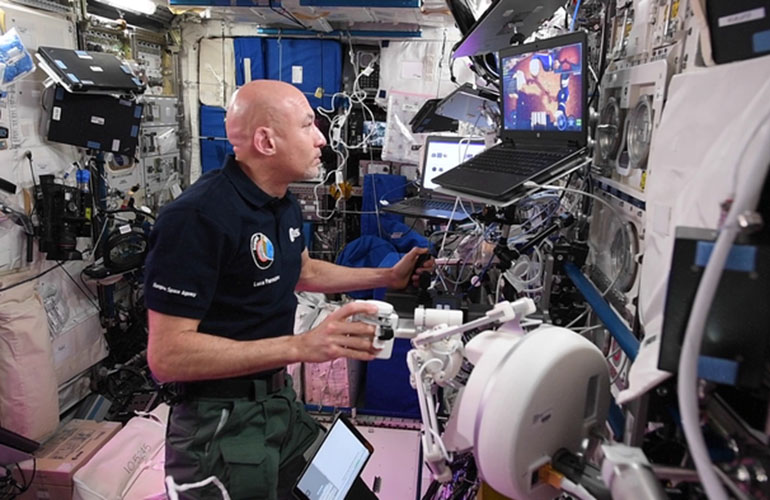|
Listen to this article  |

Luca Parmitano operating a robot on Earth from the ISS. | Source: ESA
The European Space Agency (ESA) carried out the first phase of its ANALOG-1 experiment. Astronaut Luca Parmitano controlled a robot in an artificial lunar landscape on Earth from the International Space Station. A paper published in Open Astronomy by Kjetil Wormnes and colleagues at the ESA details the experiment.
The team hopes that their research could be used to perform complex missions on the lunar surface. Robots need human control to make these kinds of mission possible but, until the ANALOG-1 experiment in November 2019, no one had ever received direct haptic feedback in space from a robot.
In the experiment, Parmitano controlled a robot roving the old Valkenburg air base in the Netherlands. The robot carried out its tasks of selecting, investigating and storing rock samples. Parmitano was able to control the robot’s arm as it moved through three translational and three rotational degrees of freedom.
Parmitano was also able to feel the weight of rocks as the robot’s arm picked them up and manipulated them.
10 years in the making
The ANALOG-1 experiment is the culmination of 12 experiments that the ESA has carried out since 2011 and knowledge gained from an internal ESA study in 2009.
The 12 experiments leading up to ANALOG-1 were part of the METERON project. This project is focused on preparing for future human-robotic exploration missions to the Moon, Mars and other celestial bodies.
The ESA carried out the METERON experiments to test each piece of the system used in ANALOG-1. Among other things, the experiments tested technical implementation, development of user interfaces, autonomy concepts, operational concept and interaction with scientists.
The test performed in 2019 is only the first part of ANALOG-1. The second part of the experiment involves the rover exploring an outdoor lunar analogue at Mount Etna. This part of the experiment does not involve an astronaut on the ISS.
The ESA planned to carry out the second part of ANALOG-1 in the summer of 2020, but had to postpone the test until 2022 due to the pandemic.
Credit: Source link


Comments are closed.